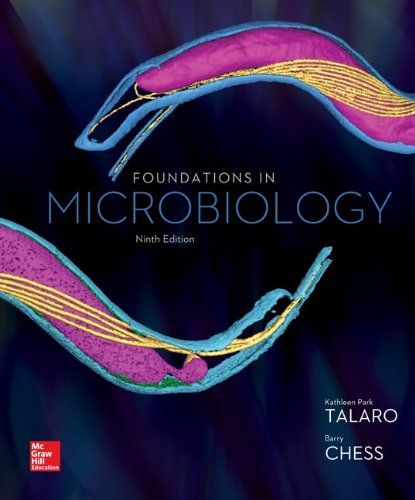Foundations In Microbiology 9th Edition By Talaro Chess – Test Bank
Original price was: $55.00.$22.00Current price is: $22.00.
Digital item No Waiting Time Instant Download
ISBN-10: 0073522600 ISBN-13: 978-0073522609
Publisher : McGraw-Hill Education; 9th edition
Authors: y Kathleen Park Talaro, Barry Chess
Description
Foundations In Microbiology 9th Edition By Talaro Chess – Test Bank
Sample Chapter No:3
Student: ___________________________________________________________________________
- The Six I’s of studying microorganisms include all of the following except A. inoculation.
B. incubation. C. infection.
D. isolation.
E. identification. - All of the following are examples of different types of microbiological media except A. broth.
B. enriched. C. agar.
D. petri dish. E. gelatin. - The term that refers to the purposeful addition of microorganisms into a laboratory nutrient medium is
A. isolation.
B. inoculation. C. immunization. D. infection.
E. contamination. - Which of the following is essential for development of discrete, isolated colonies? A. broth medium
B. differential medium C. selective medium D. solid medium
E. assay medium - A pure culture contains only
A. one species of microorganism.
B. bacteria.
C. a variety of microbes from one source. D. All of the choices are correct.
E. None of the choices are correct. - Which of the following will result when 1% to 5% agar is added to nutrient broth, boiled and cooled? A. a pure culture
B. a mixed culture
C. a solid medium
D. a liquid medium
E. a contaminated medium - A microbiologist inoculates Staphylococcus aureus into a culture medium. Following incubation, both Staphylococcus aureus and Staphylococcus epidermidis are determined to be growing in this culture. What is the most likely explanation?
A. The microbiologist used too much inoculum.B. The culture is contaminated.
C. The incubation temperature was incorrect. D. The culture medium must be selective.
E. The culture medium must be differential.
- A microbiologist inoculates Staphylococcus epidermidis and Escherichia coli into a culture medium. Following incubation, only the E. coli grows in the culture. What is the most likely explanation?
A. The microbiologist used too much inoculum.
B. The culture is contaminated.C. The incubation temperature was incorrect. D. The culture medium must be selective.
E. The culture medium must be differential. - Which method often results in colonies developing down throughout the agar and some colonies on the surface?
A. streak plate
B. spread plate
C. pour plate
D. All of the choices are correct E. None of the choices are correct - A common medium used for growing fastidious bacteria is A. blood agar.
B. trypticase soy agar. C. mannitol salt agar.
D. MacConkey medium. E. a reducing medium. - A nutrient medium that has all of its chemical components identified and their precise concentrations known and reproducible would be termed
A. complex.
B. reducing.C. enriched.
D. enumeration. E. synthetic. - A reducing medium contains
A. sugars that can be fermented.
B. extra oxygen.
C. hemoglobin, vitamins, or other growth factors. D. substances that remove oxygen.
E. inhibiting agents. - Which type of medium is able to distinguish different species or types of microorganisms based on an observable change in the colonies or in the medium?
A. differential
B. selectiveC. enumeration D. enriched
E. reducing - A microbiologist decides to use a nutrient medium that contains thioglycolic acid. What type of microbe is she attempting to culture?
A. fastidious
B. gram positiveC. anaerobe
D. gram negative E. virus
- Mannitol salt agar is selective for which bacterial genus? A. Salmonella
B. Streptococcus C. Neisseria
D. Staphylococcus E. Escherichia




Be the first to review “Foundations In Microbiology 9th Edition By Talaro Chess – Test Bank”